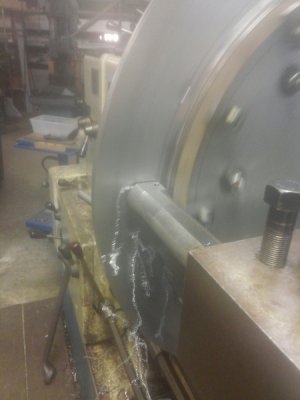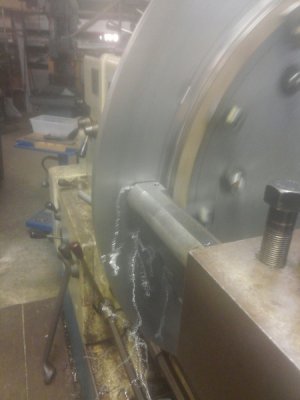- Joined
- Sep 13, 2016
- Messages
- 137
Paul,Mark,
I've read your lathe saga this evening. Congratulations on finding and having the guts to go ahead with the purchase even with the electricals being missing. I have a similar small farm situation and similar size shop area inside my pole barn. Besides the day job, I have been hay farming since the early 80's with very used equipment. By necessity I have made parts and even a main gearbox shaft within the gearbox of a JD pull behind combine. My long owned lathe is a 10" X 36" Clausing. Its size has been adequate for most of what we have needed to make. When I got it in the 80's, a good friend electrical engineer designed the details to convert it to single phase 240 V power (no 3 phase available here). Since then I have acquired a 14" X 36" gap bed Japanese lathe for some of the reasons you spoke of earlier. Like you, I trailered it and loaded and unloaded it myself with a 975 Bobcat. But I could have used one of the bigger tractors with its loader. Maybe you have a neighbor with similar equipment who is willing to help you unload. I doubt your estimated weight of 8,000 lbs if you were running a 4 wheel trailer with 35 psi tire pressure. I think you would have blown out a tire or 2. So my WAG of the machine weight is maybe 5,000 lbs, and even that + trailer dead weight exceeds what that tire pressure would sustain for a 3 hour drive. Point I am getting to is if a good size farm tractor loader is used without the weight of the empty bucket (take the bucket off) and lift with hefty straps from the front cross member of the loader frame (closer to the tractor gives greater lift), you should be able to slightly lift the lathe and then drive the trailer out from under. When moving the tractor and lathe, keep the lathe very close to the ground. Keep the straps straight and not twisted. I lift by placing the straps under the lathe bed, one close to the headstock, and one closer to the tailstock. Move the carriage toward the tailstock, to somewhat balance the load. See that the lift straps are not touching any of the levers or switches and have no interference with the carriage. Use nothing less than the 2" wide straps rated at 10,000 breaking strength. I would use 2 such straps at each end of the lathe bed. I see by your early photos, the seller used chain for lifting. I much prefer straps, much less likely damage to the machine, and they are much less likely to slip sideways than chain. As another poster pointed out, a lathe is top heavy, so lifting from the bed makes good sense. If you unload before your dolly cart is built, you can move the lathe on a dirt or gravel surface by laying down a couple of 2 x 10 planks on the dirt (space them apart maybe 10-12") cut some scrap 1 1/4" water pipe into 30 to 36" lengths , 6 pieces or more spaced about 1 ft apart perpendicular to the parallel planks, place another pair of 2 x 10 on top to the pipes and set the lathe on top of the "pipe sandwich". Working alone, I pull the machine forward using a come-along between a pole barn pole and the lathe foot. Do not pull from the bed with this setup. If you need to turn the lathe, just begin setting the pipes at a bit of an angle to the lower planks (kind of like steering it into place). As you inch forward, a pipe comes out from the back, you then put it at the front of the pull. It is easier to do, than it is to explain.
For the jack screws on your planned dolly, 2 possible suggestions: 1) If you have commercial scaffolding wheels available (with screw thread adjustments) they work very well. 2) 1/2" threaded rod or bolts may carry the weight, but I have had too many fail by bending or snapping off. 3/4" bolts or threaded rod is the smallest I would use for this application. Your farm machinery dealer parts dept might have the grade 5 threaded rod 36" long in stock. Our CNH dealer has the threaded rod selection out on the display floor.
Work slowly and carefully on this phase of the project, you'll do well.
Paul in MN
Thanks, on the trailer, let me clear that up. I had about 35 lbs for the first quarter mile. At a corner gas station using a stack of quarters, I got them up to around 45 using that cheap coin-operated compressor they had. Then I hauled 3-4 miles at a gingerly 25-30 mph, slower when I could, until I got to the Discount Tire shop Ken recommended to me, where they topped them off to 75psi. I drove home on 75 psi for 3 hours... Wouldn't have made it out of town as it was. The trailer has a GTWR of 20K. Its own weight is about 4500. The minimum weight spec I can find for this series of lathe is around 6,600. Seen them listed as high as 7,200. I figure 8,000 is a safe working estimate. It may be 1,400 or so less. I know that my little 45hp tractor routinely handles 6x6 round bales approaching the 1 ton mark. It wouldn't budge it. (I just wanted to see if I could even budge one end of it...Not a chance.) I'm going to try to Egyptian Pyramid this thing off the trailer this weekend. It's already been sitting on the trailer a week longer than I wanted. My plan is to use a pair of 3 ton floor jacks to elevate one end, stick some lengths of pipe under the pedestals, and roll it to the end of the trailer bed. From there, I will see if I can get it onto some posts I have that are 10' sections of telephone pole. If I can work it back until the tail-end pedestal is at the end of the bed of the trailer, I'm thinking I can at that point get the jacks under it, and elevate just enough to pull the trailer clear. Then, set it down on that end, go to the other end, jack it off the telephone pole, and set it down. I can use a combination of chains and tow straps to control its momentum. The way I have the trailer situated at the moment, the end of the bed is over-hanging the concrete by about 2', and since off the slab, the trailer sits about 8 inches lower, I've only got about 1' difference in height between the bed of the trailer and the surface of the concrete. Worse comes to worse, I'll hire out one of the local wrecker companies, put the trailer back on the slab, have them lift it about 1" clear of the bed, pull the trailer, and then set it straight down for now.
I've re-thought the dolly business some too. Part of the rationale for the dolly was that my small shop would require it to be movable. In another thread, I've mentioned we've decided to double my shop floorspace by extending it another 16 ft within the barn, so we'll be doing some more concrete work. That will give me the floor space to put a couple feet behind the lathe on a permanent basis. Then I'll only need to move it one time. Rather than spend the money on the steel and casters and so on, I'm going to try to find a more economical approach. I figure I'd have spent in steel and hardware for the dolly what I'll spend on concrete and rebar, more or less, but the one wall gets 16' longer, as does the lowered ceiling deck, so a little added cost. Not too bad though. Thing is, I'll still need to find a way to move this thing one time once it's on the ground. It can sit in that center aisle for quite a while as I do some of the basic structural work for the shop. It doesn't need to move, and then when it does, I'll need to figure something out. I looked at some heavy duty car dollies, but the only thing I worry about there is weight distribution on the dollies themselves. They're made to have a tire resting on them, laying in the trough formed by the wide V of the platform. Not sure how they'd work with something heavy laid across the tops of them. Found some that will support 2,500 lbs each, sold in pairs for reasonable amounts, thought maybe I could buy two pairs, support the headstock pedestal with a pair, the mid pedestal with one, and the tail pedestal with another, or something along those lines. Would be a heckuva lot cheaper than my custom cradle/dolly business, and would have other uses(like a car, for instance...LOL)
Anyway, that's where I'm at.
Thanks Paul!
Mark
When we loaded it on the trailer, I had them position it for proper weight distribution fore/aft with respect to the loading of the axles and tongue. I got it pretty close, but as I got up to around 60mph after airing up those tires, I saw just a little wandering in the tail that told me I had the weight ever so slightly to far rearward. Pulled over on the shoulder, and cranked the carriage about a foot closer to the tailstock, got it back up to speed, and yep, that made the difference. Tracked fine after that. Anyway, the jack-screws I had planned for the dolly were going to be 1" grade 8 pipe flange studs.
I was studying the lathe a little, and noticed in the end of the headstock end pedestal, there are two rectangular holes cut into the pedestal, close to the centerline, very near the bottom of the pedestal on the end. It looks like a jacking point




